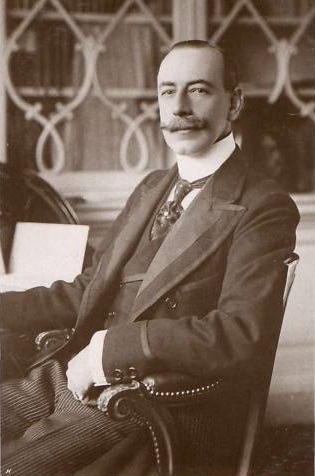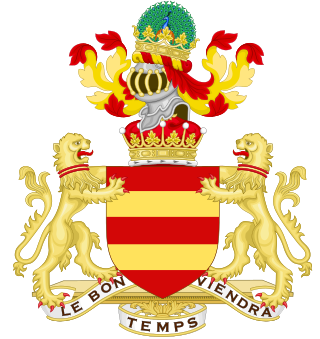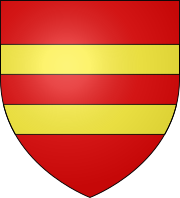
The title of Earl of Athlone has been created three times.

Lewis Vernon Harcourt, 1st Viscount Harcourt, was a British Liberal Party politician who held the Cabinet post of Secretary of State for the Colonies from 1910 to 1915. Lord Harcourt's nickname was "Loulou".

Simon Harcourt, 1st Earl Harcourt,, known as Viscount Harcourt between 1727 and 1749, was a British diplomat and general who became Viceroy of Ireland.

Simon Harcourt, 1st Viscount Harcourt, PC of Stanton Harcourt, Oxfordshire, was an English Tory politician who sat in the English and British House of Commons from 1690 until 1710. He was raised to the peerage as Baron Harcourt in 1711 and sat in the House of Lords, becoming Queen Anne's Lord High Chancellor of Great Britain. He was her solicitor-general and her commissioner for arranging the union with Scotland. He took part in the negotiations preceding the Peace of Utrecht.

Viscount Hereford is the oldest and only extant viscountcy in the Peerage of England, making the holder the Premier Viscount of England. The title was created in 1550 for Walter Devereux, 10th Baron Ferrers of Chartley.

Earl of Glasgow is a title in the Peerage of Scotland. It was created in 1703 for David Boyle, Lord Boyle.

Earl of Halifax is a title that has been created four times in British history—once in the Peerage of England, twice in the Peerage of Great Britain, and once in the Peerage of the United Kingdom. The name of the peerage refers to Halifax, West Yorkshire.

Earl Jellicoe is a title in the Peerage of the United Kingdom. It was created, along with the subsidiary title Viscount Brocas, of Southampton in the County of Southampton, on 29 June 1925 for Admiral of the Fleet John Jellicoe, 1st Viscount Jellicoe, on his return from being Governor-General of New Zealand, with remainder to the heirs male of his body. He had already been created Viscount Jellicoe, of Scapa in the County of Orkney, on 15 January 1918, created with remainder to the heirs male of his body, and in default of such issue to his eldest daughter and the heirs male of her body, with the like remainder in default of such issue to every other daughter successively in order of priority of birth, and to the heirs male of their bodies. The Jellicoe viscountcy was created with remainder to his daughters and their heirs male because, at the time of the creation, Jellicoe had five daughters and no sons. His only son was born three months later.

Earl of Strafford is a title that has been created three times in English and British history.

Viscount Hardinge, of Lahore and of Kings Newton in the County of Derby, is a title in the Peerage of the United Kingdom. It was created in 1846 for the soldier and Tory politician Sir Henry Hardinge. His son, the second Viscount, represented Downpatrick in Parliament. His great-great-grandson, the sixth Viscount, succeeded a distant relative as eighth Baronet, of Belle Isle in the County of Fermanagh, in 1986. This title had been created in the Baronetage of the United Kingdom 1801 for Richard Hardinge. He was the third son of Nicolas Hardinge, younger brother of Reverend Henry Hardinge and uncle of the latter's third son Henry Hardinge, 1st Viscount Hardinge. The baronetcy was created with special remainder to the heirs male of Richard Hardinge's father.

Baron Vernon, of Kinderton in the County of Chester, is a title in the Peerage of Great Britain. It was created in 1762 for the former Member of Parliament George Venables-Vernon. He had previously represented Lichfield and Derby in the House of Commons. Born George Vernon, he was the son of Henry Vernon, of Sudbury in Derbyshire, and Anne Pigott, daughter and heiress of Thomas Pigott by his wife Mary Venables, sister and heiress of Sir Peter Venables, Baron of Kinderton in Cheshire. In 1728, he assumed by Royal Licence the additional surname of Venables upon inheriting the Venables estate in Cheshire from his childless cousin Anne, widow of the 2nd Earl of Abingdon.

Baron Dufferin and Claneboye, of Ballyleidy and Killyleagh in County Down, Northern Ireland, is a title in the Peerage of Ireland. It was created on 30 July 1800 for Dame Dorcas Blackwood, widow of Sir John Blackwood, 2nd Baronet, Member of the Irish Parliament for Killyleagh and Bangor, in return for support for the Union of Ireland and the United Kingdom.

Earl Harcourt, of Stanton Harcourt in the County of Oxford, was a title in the Peerage of Great Britain. It was created in 1749 for Simon Harcourt, 2nd Viscount Harcourt. He was made Viscount Nuneham at the same time, also in the Peerage of Great Britain. Harcourt was the son of the Honourable Simon Harcourt and the grandson of Simon Harcourt, Lord High Chancellor of Great Britain, who had been created Baron Harcourt, of Stanton Harcourt in the County of Oxford, on 3 September 1711, and Viscount Harcourt, of Stanton Harcourt in the County of Oxford, on 24 July 1721. Both these titles were also in the Peerage of Great Britain.

Nuneham Courtenay is a village and civil parish about 5 miles (8 km) SSE of Oxford. It occupies several miles close to the east bank of the River Thames.

George Venables-Vernon, 1st Baron Vernon, was a British politician.
The Vernon family was a wealthy, prolific and widespread English family with 11th-century origins in Vernon, Normandy, France. Their extant titles include Baron Vernon and Vernon baronets of Shotwick Park.

George Simon Harcourt, 2nd Earl Harcourt, styled Viscount Nuneham until inheriting the title of Earl Harcourt in 1777, was an English politician, patron of the arts, and gardener.

Mary Ethel Harcourt, Viscountess Harcourt GBE (née Burns; 26 August 1874 – 7 January 1961) was an American-born British aristocrat and philanthropist.
Hon. Simon Harcourt was an English politician who sat in the House of Commons from 1710 to 1715.
William Edward Harcourt, 2nd Viscount Harcourt was an English aristocrat and businessman. Harcourt was a member of the distinguished Harcourt family, who descended from the ancient House of Harcourt in Normandy.














